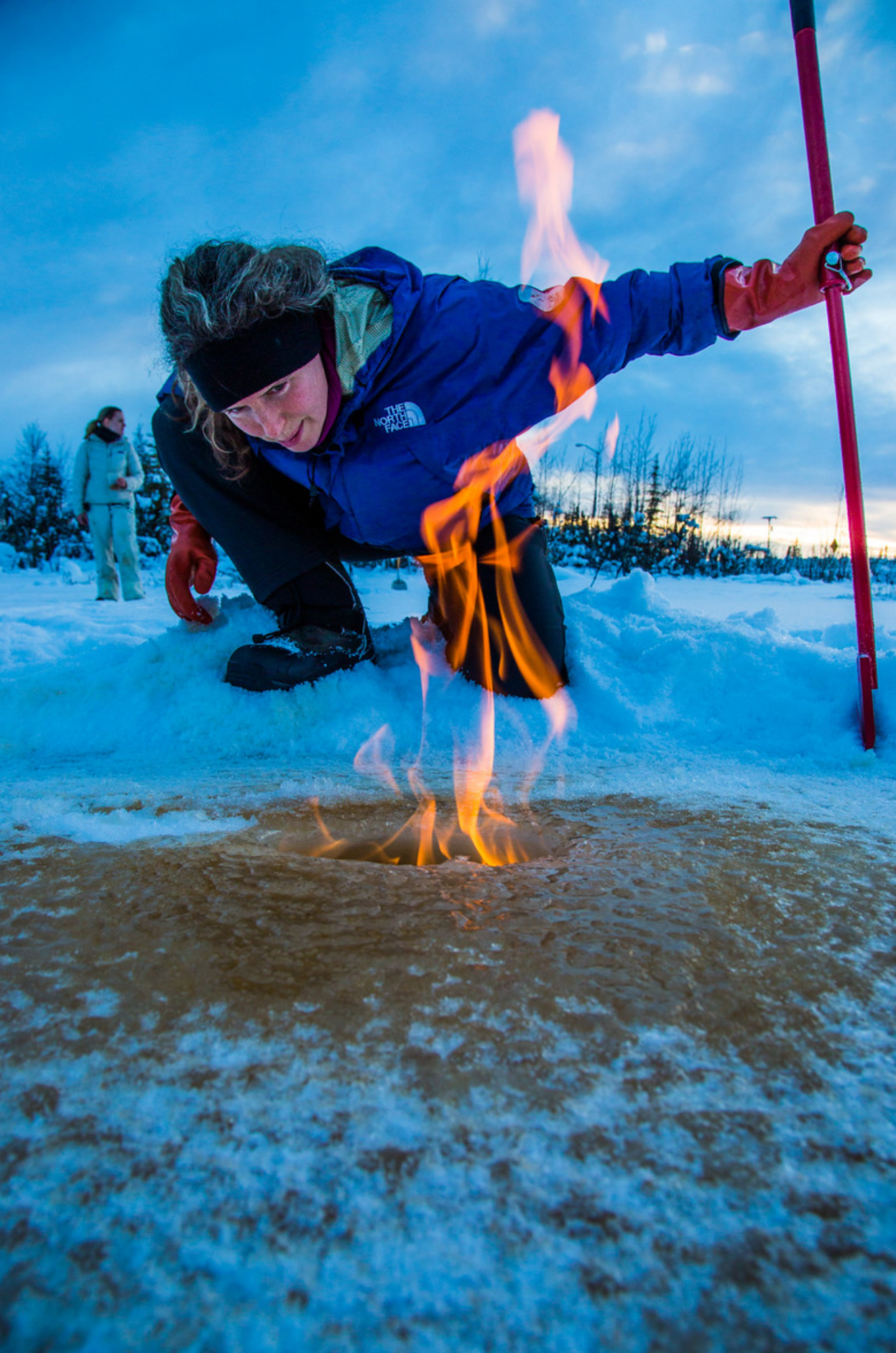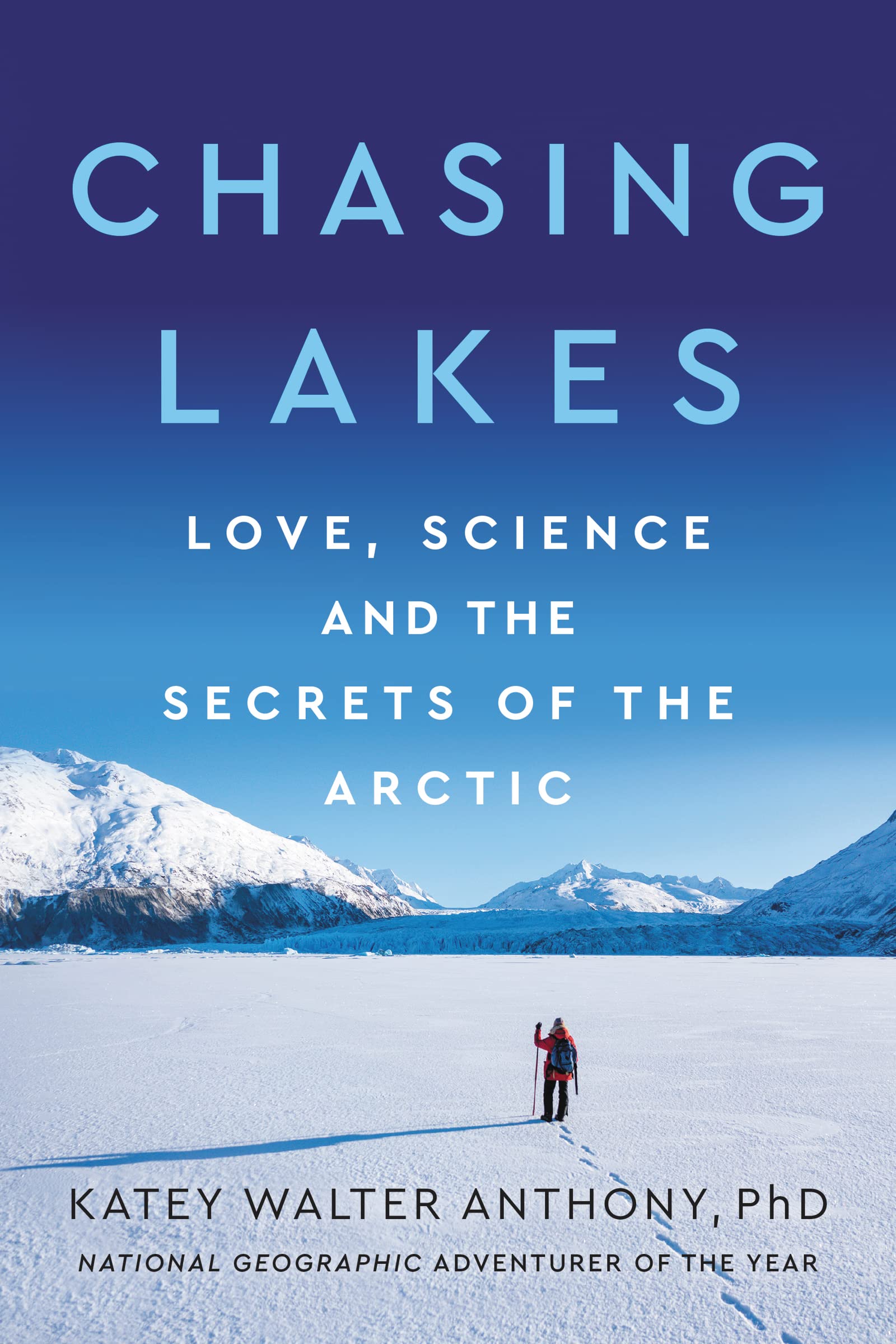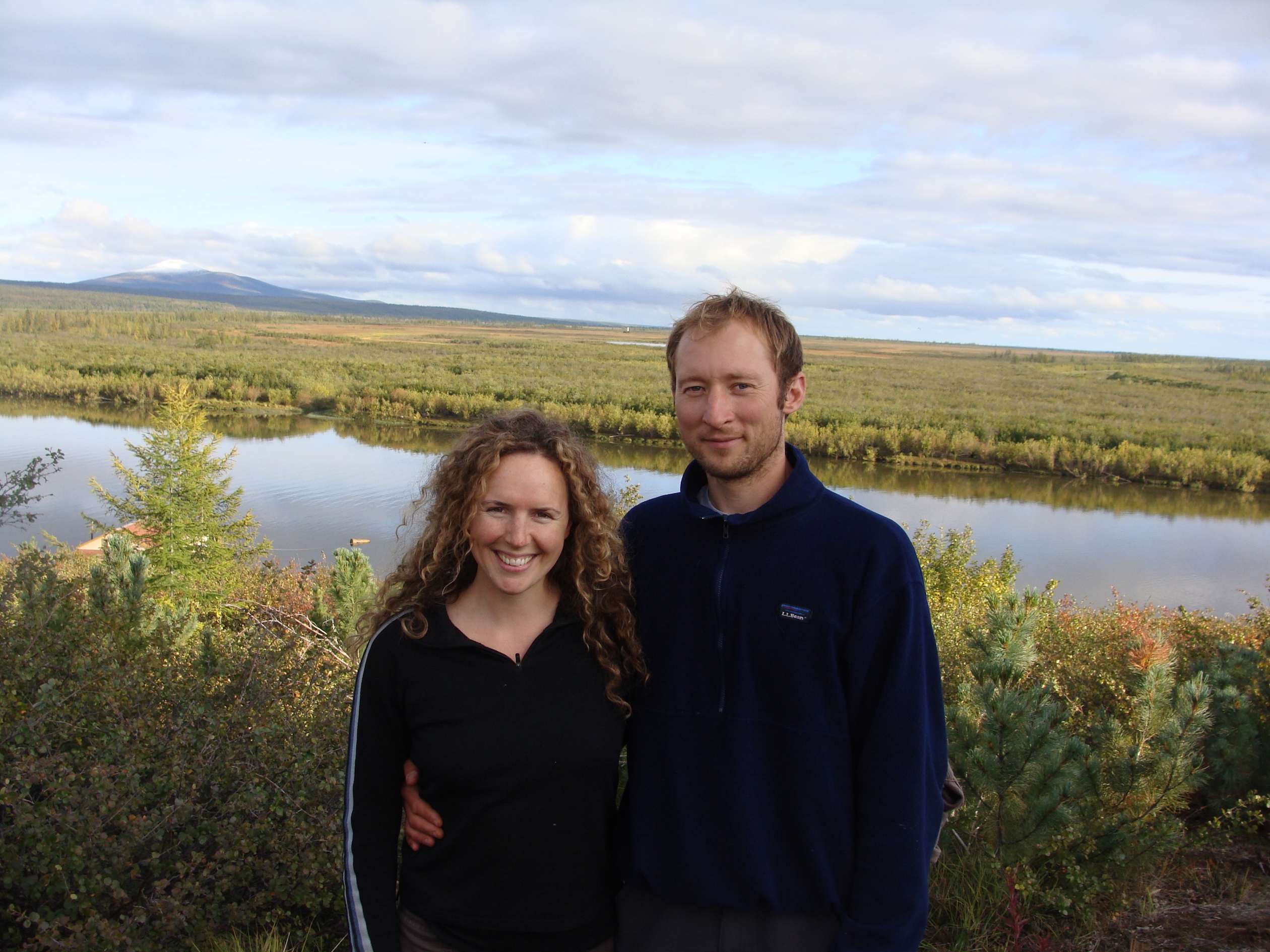Scientist’s memoir is revealing and brave
Ned Rozell
907-474-7468
June 3, 2022

Katey Walter Anthony inspects flaming methane gas seeping from a hole in the ice on the surface of a pond on the UAF campus in February 2016.
In her recently published memoir, Katey Walter Anthony writes that a certain type of northern lake is a lot like herself.
“A thermokarst lake is born to promote itself at all costs. A full force of nature, it gnaws away at the icy, carbon-rich permafrost soils stored in the land around it.
“It takes more than it gives, and what it does give is not always good for the world.”
That self-critical description is a recurring theme of Walter Anthony’s book, “Chasing Lakes: Love, Science, and the Secrets of the Arctic.” It is a unique mix of science and Christianity. The book is also a reflection on the challenges and rewards of choosing to marry and become a parent.
Katey Walter Anthony is a scientist at the University of Alaska Fairbanks who studies northern lakes that emit the invisible greenhouse gas methane, a formerly overlooked factor in the equation of global warming.
Photos of her crouching on frozen lakes while igniting plumes of methane have appeared in stories seen all over the world. After a 2018 feature in the Washington Post by Chris Mooney, a literary agent from a major publishing firm in New York City contacted Walter Anthony.
He asked if she might be interested in writing a book. She was, and editors at Harper Collins accepted her proposal.
The result is a book that takes the reader to unexpected places — first to a pond that I rode around today as it eats into a Fairbanks bike path. Walter Anthony opens the book there by describing a thermokarst pond, one of millions in Alaska and Siberia.
“Thermokarst” describes a northern sinkhole created by heat. A Russian expression for its growth is “lake eating into land.”
As the warmth of the air helps these lakes expand by thawing ground around them that had been frozen for perhaps thousands of years, microorganisms feast on the suddenly available specks of ancient plants and mammoth femurs. In digesting those, microbes belch out methane, a potent greenhouse gas. It wafts skyward from these black bodies of water in a constant stream.

Walter Anthony described this action at the little pond by the bike path, which she has studied for years.
“The dime-size bubbles dance out, coming to rest in a perfect, two-foot wide circle, where they pause for a moment before bursting to join our atmosphere.”
That leakage of methane into our airspace is significant, and Walter Anthony has been relentless in her quest to capture and document it. In her book, she describes her adventurous times in Siberia, Greenland and, of course, Alaska.
She writes of her breakthrough moments, such as when her mentor Sergey Zimov walked her onto the thin ice of frozen lakes in Siberia one fall day.
“Bubble traps” she had constructed in Russia out of plastic bottles and other trash she had gathered were not capturing the exhalations of the lakes. On that hike with Zimov, bubbles of methane frozen into the ice like stacks of white coins revealed dependable hot spots of lake emissions (and where to deploy her traps).
“I gawked in wonder,” she wrote. “The ice sheet was an incredible time-lapse photograph of bubbling.”
Those and other discoveries led her, with colleagues including Guido Grosse of the Alfred Wegener Institute in Germany, to include the methane wafting from northern lakes as an input to a climate computer model that predicts permafrost-carbon emissions.
“The results were shocking!” she wrote. “Including lakes more than doubled the climate warming impact of thawing permafrost in the twenty-first century. While new lakes would occupy only a tiny fraction of the Arctic, they would be responsible for about half of all permafrost-derived warming.”
Walter Anthony is a driven scientist, and readers would have accepted a book solely on her work (though we always want the human details). But, as when she left home as a teenager to live in Russia, Walter Anthony did not choose the easy path in writing her memoir.
She includes Bible passages and goes into great detail about meeting and starting a family with her husband Peter.
It’s here where she is at her bravest. In one passage, she reflects on feeling lonely within her small Fairbanks cabin and then receiving guidance from an inner voice.

Katey Walter Anthony and Peter Anthony in Cherskii, Russia.
“(God) was telling me he loved me. He was freeing me of the expectations I had laid on my father and on any human relationship. I understood now, in a way I never had before, that God loved me perfectly, like no human ever possibly could. This was enough . . . At that moment, I started to love my Lord.”
Walter Anthony said she wanted to write the book “for personal reasons, the first of which was to write down the memories of my life before children, since children have a way of drawing us into the present and eclipsing our past.”
She navigates the tricky terrain of being a world-class scientist who married a farmer from Minnesota she met at a wedding at the Dog Musher’s Hall in Fairbanks. Peter Anthony is the owner of a large farm in Minnesota, where the couple and their two boys now spend some of their time. He also partners with her on her Arctic science expeditions, using his farmer’s know-how and work ethic to find solutions she would not have on her own.
Walter Anthony also writes of the depression she battled as a Minnesota farm-wife, at least for part of the year. There, she credits her faith in helping her.
“This farm was a place I had resented. It had taken me away from the mountains, from the Arctic, and from Russia. It had taken me away from daily interactions with students and colleagues on campus and opportunities to pursue invitations for professorships.
“I knew that to become free I would have to continue to die to self. I would have to let my pride go in order to become something new, someone God was molding me into — something I trusted and at the same time feared would bring a joy that was not of myself.”
Walter Anthony’s work has brought to our consciousness a dire threat — carbon stored in frozen ground beneath much of the north is a “time bomb” of greenhouse gases now brushing our cheeks as we walk through our world. I wondered what message of hope for the planet she might offer with the far-reaching platform provided by a major publishing house.
From her epilogue:
“We are well on our way to an Arctic that will be at least seven degrees warmer by the end of this century,” she wrote. “We can hope and strive to slow this warming, but change itself is unpreventable. Change has always happened.
“We can let the idea of change become a festering wound inside us, or we can adapt to the changes, allowing them to instead become something we can perceive as opportunity for improvement.
“I believe the biggest impacts on both our attitudes and the environment could be for more people to step outside and rekindle a long-lost love of the natural world.”
Since the late 1970s, the University of Alaska Fairbanks' Geophysical Institute has provided this column free in cooperation with the UAF research community. Ned Rozell is a science writer for the Geophysical Institute.


